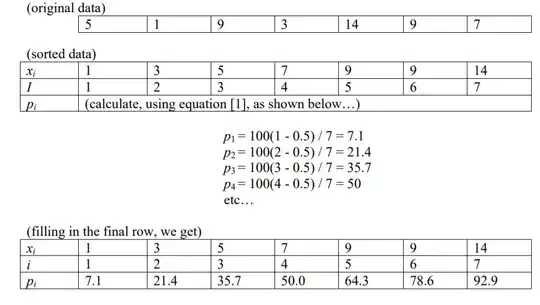Are there 99 percentiles, or 100 percentiles? And are they groups of numbers, or divider lines, or pointers to individual numbers?
I suppose the same question would apply for quartiles or any quantile.
I have read that the index of a number at a particular percentile(p), given n items, is i = (p / 100) * n
That suggests to me that there are 100 percentiles.. because supposing you have 100 numbers(i=1 to i=100), then each would have an index(1 to 100).
If you had 200 numbers, there'd be 100 percentiles, but would each refer to a group of two numbers. Or 100 dividers excluding either the far left or far right divider 'cos otherwise you'd get 101 dividers. Or pointers to individual numbers so the first percentile would refer to the second number, (1/100)*200=2 And the hundredth percentile would refer to the 200th number (100/100)*200=200
I have sometimes heard of there being 99 percentiles though..
Google shows the oxford dictionary that says of percentile- "each of the 100 equal groups into which a population can be divided according to the distribution of values of a particular variable." and "each of the 99 intermediate values of a random variable which divide a frequency distribution into 100 such groups."
Wikipedia says "the 20th percentile is the value below which 20% of the observations may be found" But does it actually mean "the value below or equal to which, 20% of the observations may be found" i.e. "the value for which 20% of the values are <= to it". If it were just < and not <=, then By that reasoning, the 100th percentile would be the value below which 100% of the values may be found. I have heard that as an argument that there can be no 100th percentile, because you can't have a number where there are 100% of the numbers below it. But I think maybe that argument that you can't have a 100th percentile is incorrect and is based an error that the definition of a percentile involves <= not <. (or >= not >). So the hundredth percentile would be the final number and would be >= 100% of the numbers.


